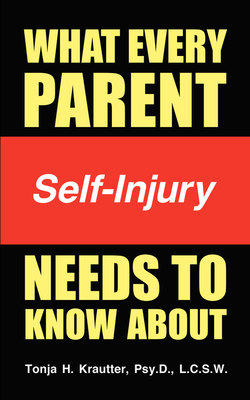Читать книгу What Every Parent Needs to Know About Self-Injury - Tonja Krautter - Страница 6
На сайте Литреса книга снята с продажи.
Types of Self-Injury
ОглавлениеThe most common form of self-injury is cutting. There are many objects that individuals use to cut themselves with, including knives, razor blades, and glass. However, individuals who self-injure are not limited to these items. In fact many use instruments that most people would not even think of as something that could cause bodily harm. For example, it is not uncommon for self-injurers to use push pins, paper clips, nail files or staples to inflict injury.
It is also not uncommon for self-injurers to transform a harmless object into a sharp instrument to be used for self-harm. For example, Haley was hospitalized for suicidal ideation last spring. She was known on the hospital ward as a “cutter.” She was placed on suicide watch and almost everything that could cause harm was removed from her room. She was only allowed a marker and paper for journaling. Each day she sharpened the marker’s cap with her teeth, creating a pointed edge she used to cut her arms and legs when she felt the desire. She also gave herself paper cuts with the edges of the paper that was provided to her on a daily basis.
Hillary was Haley’s roommate. She took the hooks that held the curtains in place and used them to scratch her arms and legs before going to bed at night. In addition, she found sharp pieces of metal protruding from one of the legs under a table in the TV room and while still attached, used them to scratch her feet and ankles.
Clearly, if someone is motivated to self-injure they will find a way. The solution is not to try to take away every item that could be used for self-harm, since that would be next to impossible. Instead, the goal is to help the individual control the desire to self-harm, and to help them better tolerate the overwhelming feelings that are present in their lives (See Chapter 8).
The second most common form of self-injury is burning. Like cutting, there are a variety of implements an individual may use in order to burn herself, including a lighter, matches, cigarette, cigar, candle, stove top, and/or a piece of metal that has been heated by fire. Joey, 17 years old, has been burning different parts of his body since he was 11. He remembers the first time he burned himself in a game of chicken with his friend. He and his friend put a burning cigarette between their arms and the first person to pull away was bequeathed with the title of “chicken.”
Joey was determined to win the game. He recalls, “Winning made me feel tough. I was able to tolerate the physical pain longer than anyone else in my grade.” Joey developed a belief system in which tolerating physical pain made him strong and respected by his peers. He received positive reinforcement for being “the toughest kid at school.” Joey took great pleasure in challenging everyone he knew to the game of chicken.
When the game lost its novelty and others lost interest in playing, Joey began to play the game with himself. This time, he competed against the clock. How long could he stand the pain? The longer the amount of time that passed, the stronger and more powerful he felt. It did not take him long to realize that every time he was feeling powerless, he could burn himself and regain a sense of strength and self-confidence.
